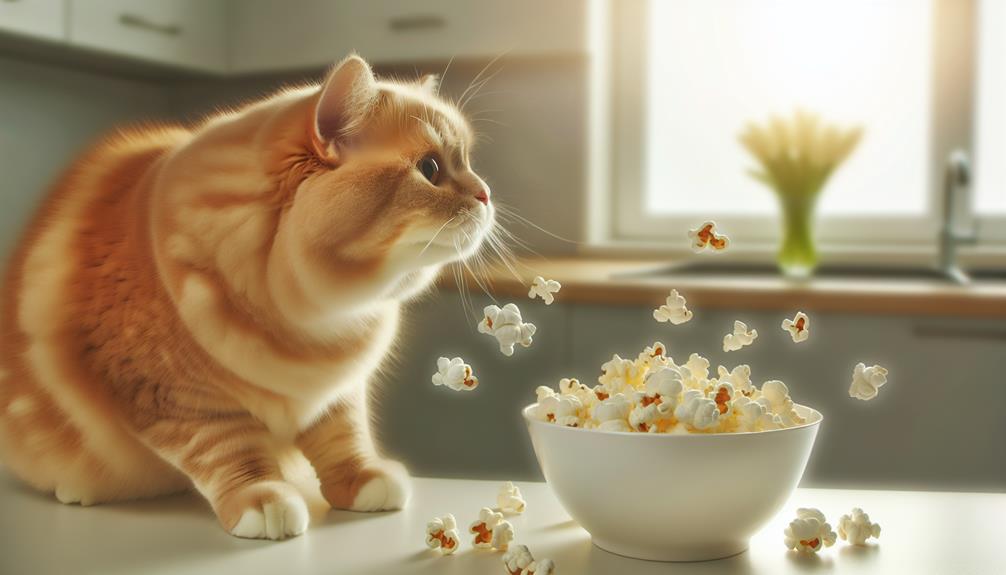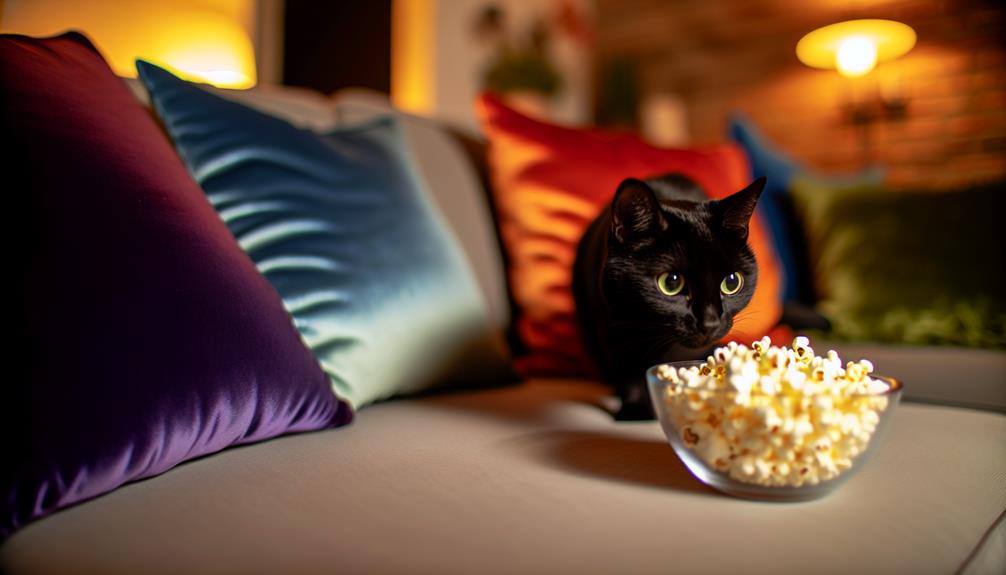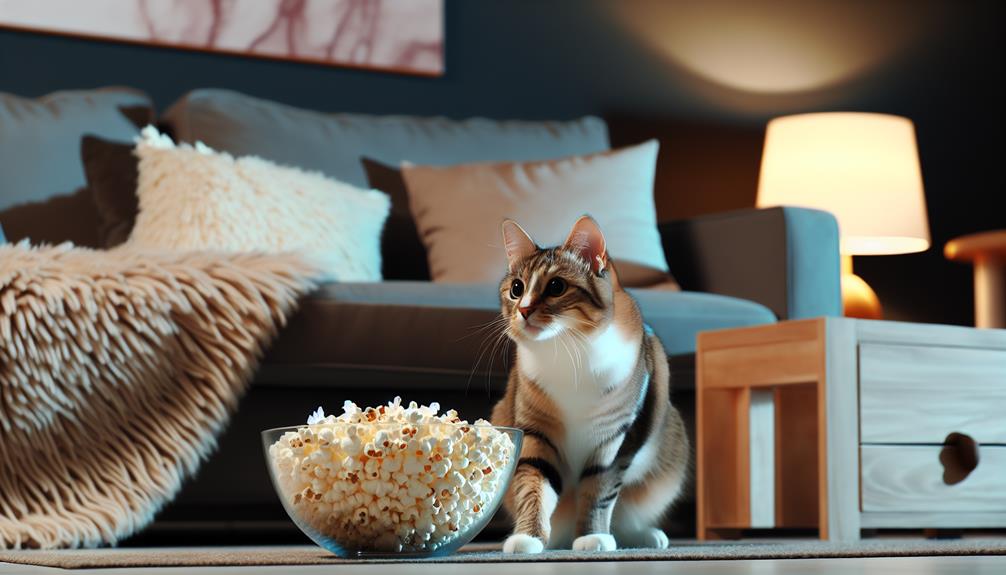Just as Pandora opened the box, you might wonder if opening a bag of popcorn could release unexpected consequences for your feline friend. Cats can indeed eat popcorn, but it's not as straightforward as sharing your favorite movie snack. You need to evaluate the nutritional content, potential risks, and safe ingredients before tossing a kernel their way. Is it safe to give them buttered or salted popcorn? What about the possibility of choking on unpopped kernels? Before you decide to share, let's explore the details to guarantee your cat's safety and well-being.
Nutritional Content of Popcorn
Have you ever wondered what makes up the nutritional content of popcorn? Popcorn, in its purest form, is fundamentally a whole grain. It contains a variety of nutrients that can be beneficial for humans, such as fiber, vitamins, and minerals. But how does this translate to cats, and are there any popcorn benefits that could aid in their digestion?
From a clinical perspective, popcorn is mainly composed of carbohydrates, which provide a quick source of energy. It also contains a moderate amount of fiber, which is known to aid in digestive health. For cats, who are obligate carnivores, their digestive systems are not primarily designed to process large amounts of carbohydrates or fiber. However, in small amounts, the fiber in popcorn could potentially assist in preventing constipation by promoting regular bowel movements.
Popcorn also contains trace amounts of vitamins such as B-complex vitamins, which play a role in metabolism, and minerals like magnesium and potassium, which are vital for various bodily functions. While these nutrients are beneficial, it's important to recognize that the quantities present in popcorn are minimal and not sufficient to meet a cat's dietary requirements.
When considering cat digestion, it's important to understand that their gastrointestinal system is optimized for meat consumption. While small amounts of plain, air-popped popcorn are unlikely to cause harm, it doesn't provide substantial nutritional benefits. Consequently, any perceived popcorn benefits for cats are marginal at best. Always keep in mind that the overall diet should be specifically tailored to meet a cat's nutritional needs, prioritizing high-quality animal proteins and essential nutrients.
Potential Risks for Cats
Despite its seemingly harmless appearance, popcorn can pose several potential risks for cats. Cats have a unique digestive system that is not designed to process many human foods, including popcorn. When considering feline digestion, it's important to recognize that certain components of popcorn can lead to gastrointestinal distress and more severe health issues.
First, let's address the concept of popcorn toxicity. While popcorn itself isn't inherently toxic to cats, the additives often found on popcorn can be. Ingredients such as butter, salt, and artificial flavors can be harmful to your feline friend. Additionally, the texture of popcorn poses a choking hazard, especially for smaller cats or kittens.
Here's a detailed list of potential risks:
- Choking Hazard: Popcorn kernels can get lodged in your cat's throat, leading to choking or even aspiration into the lungs.
- Gastrointestinal Upset: Ingredients like salt and butter can cause vomiting, diarrhea, and other forms of gastrointestinal distress.
- Nutritional Deficiency: Popcorn lacks essential nutrients required for a cat's diet, leading to potential deficiencies if consumed in large quantities.
- Obesity: High-fat content from buttered popcorn contributes to unnecessary calorie intake, increasing the risk of obesity.
- Pancreatitis: High-fat foods can inflame the pancreas, leading to pancreatitis, a serious and painful condition.
Understanding these risks underscores the importance of monitoring what your cat consumes. Popcorn, though seemingly benign, can lead to significant health issues when not carefully managed. It's always best to consult with a veterinarian before introducing any new food into your cat's diet. This guarantees that you're making informed choices that prioritize your feline companion's health and well-being.
Safe Popcorn Ingredients

When considering safe popcorn ingredients for cats, it's essential to stick to plain, air-popped kernels without any additives. Butter and salt can pose significant health risks, including gastrointestinal distress and sodium toxicity. Be vigilant about harmful additives like artificial flavors and preservatives, which can exacerbate these risks.
Plain Popcorn Ingredients
Plain popcorn, when devoid of additives, can occasionally be considered a safe treat for cats. This is because the fundamental ingredients used in popcorn preparation—corn kernels and heat—do not inherently contain substances that are toxic to felines. However, it's essential to understand that cats have specific dietary needs and preferences that must be prioritized.
When preparing plain popcorn for your cat, guarantee that the kernels are air-popped and free from any additional flavorings. The simplicity of plain popcorn means there are fewer risks of adverse reactions, provided it's given in moderation. Here are some key points to keep in mind:
- Corn Kernels: Ensure they are fully popped to avoid choking hazards.
- Air-Popping Method: This preparation method is safest as it avoids oils and additives.
- Portion Control: Only offer a small amount as an occasional treat.
- Observation: Monitor your cat for any signs of gastrointestinal distress.
- Freshness: Use fresh popcorn to avoid any potential mold growth or spoilage.
Butter and Salt
While butter and salt might be staple additions to human popcorn, they aren't suitable for feline consumption. Butter toxicity in cats is a significant concern due to the high-fat content and lactose. Cats lack the necessary enzymes to digest lactose efficiently, leading to gastrointestinal issues such as diarrhea and vomiting. Additionally, the high-fat content in butter can contribute to obesity and pancreatitis, a painful and potentially life-threatening condition.
Salt consumption poses another risk. Excessive salt intake can lead to hypernatremia, a condition characterized by elevated sodium levels in the blood. Symptoms of salt toxicity in cats include increased thirst, lethargy, and, in severe cases, seizures or even death. Cats have a much lower tolerance for salt compared to humans, making even a small amount risky.
Harmful Additives Awareness
Understanding the potential dangers of harmful additives in popcorn is vital for guaranteeing your cat's safety. Cats are particularly sensitive to certain chemicals and substances that are often used in human foods for flavor enhancements and preservation. While plain, air-popped popcorn might seem benign, additives can pose significant health risks to your feline friend.
Additive effects can range from mild gastrointestinal distress to severe toxicity, depending on the substance and the quantity ingested. Common harmful additives in flavored popcorn include:
- Artificial flavorings: These can contain chemical compounds that are unsafe for cats.
- Salt: Excessive sodium intake can lead to hypernatremia, causing dehydration and kidney damage.
- Butter: Often containing preservatives and emulsifiers that can be harmful.
- Sweeteners: Xylitol is particularly toxic to cats, leading to hypoglycemia and liver failure.
- Colorants: Artificial dyes might cause allergic reactions or worse.
When providing popcorn to your cat, it's important to avoid these additives entirely. Opt for plain, air-popped popcorn without any seasoning or flavor enhancements. This way, you minimize the risk of adverse additive effects and guarantee a safer snack for your feline companion.
Harmful Additives to Avoid
When evaluating whether popcorn is safe for cats, it is vital to take into account harmful additives that could pose health risks. Popcorn, in its plain form, may seem harmless, but the inclusion of certain additive types can introduce compounds that are detrimental to feline health. For instance, butter, salt, and artificial flavorings are commonly added to popcorn for human consumption, but these are not safe flavors for cats.
Butter and other forms of fats can lead to gastrointestinal upset and obesity, given that cats have a low tolerance for high-fat foods. Salt, or sodium chloride, can cause sodium ion poisoning in cats, manifesting in symptoms like vomiting, diarrhea, and even seizures in severe cases. Artificial flavorings, often derived from synthetic chemicals, can introduce toxic substances into your cat's system, further complicating their health.
Additionally, some popcorn varieties contain additives like xylitol, a sugar substitute that is extremely toxic to cats even in small amounts. Similarly, garlic and onion powders, sometimes used to flavor popcorn, contain thiosulfates, which can cause oxidative damage to red blood cells, leading to hemolytic anemia.
From a clinical perspective, avoiding these harmful additives is vital for maintaining your cat's health. If you must share popcorn with your feline friend, make sure it is plain, air-popped, and free from any added seasonings or flavorings. By understanding the various additive types and recognizing safe flavors, you can protect your cat from inadvertent exposure to harmful substances, thereby safeguarding their well-being. Always consult your veterinarian before introducing any new food into your cat's diet.
Popcorn in Moderation

Given the numerous harmful additives commonly found in flavored popcorn, it's clear that any popcorn shared with your cat must be plain and devoid of such substances. In moderation, plain popcorn can be a safe treat for your feline friend, provided it's air-popped and free from salt, butter, and artificial flavorings. Let's investigate the reasonings and guidelines for this.
From a nutritional standpoint, popcorn offers minimal benefits to cats. Its primary components, carbohydrates and fiber, aren't essential to a feline's diet, which is obligately carnivorous. Cats derive their necessary nutrients from protein and fat sources, primarily from meat. However, the occasional plain popcorn kernel can serve as a novel textural experience that aligns with some feline preferences for crunchy foods.
When offering popcorn to your cat, consider the following points:
- Portion Control: Limit the amount to a few kernels to prevent overconsumption.
- Observation: Monitor your cat for any adverse reactions, such as digestive upset.
- Choking Hazard: Ascertain the popcorn pieces are adequately sized to avoid choking.
- Frequency: Treats should be occasional, not regular parts of their diet.
- No Additives: Always verify the popcorn is free from salt, butter, and flavorings.
Clinically, it's important to remember that while plain popcorn isn't toxic, it lacks the nutritional profile required for a cat's health. A balanced diet, rich in animal proteins and essential nutrients, should always be the foundation of your cat's feeding regimen. Therefore, while popcorn can be a fun, occasional treat, it should never replace nutritionally complete cat food. By adhering to these guidelines, you can safely explore this unique treat within the boundaries of feline dietary needs.
Alternatives to Popcorn
While plain popcorn can occasionally be a safe treat for cats, there are several healthier and more nutritionally appropriate alternatives you can consider. Cats are obligate carnivores, meaning their diet should primarily consist of meat-based proteins. Consequently, offering them cat safe snacks specifically formulated to meet their dietary requirements is essential.
Recommended Alternatives to Popcorn
| Alternative | Description | Benefits |
|---|---|---|
| Freeze-Dried Meat Treats | 100% meat, no additives | High protein, low in carbohydrates |
| Commercial Cat Treats | Specially formulated for feline health | Balanced nutrients, fortified with essential vitamins |
| Cooked Chicken Pieces | Plain, unseasoned chicken | High-quality protein, palatable and easy to digest |
| Catnip-Infused Crunchy Treats | Crunchy treats with added catnip | Stimulates appetite, provides mental stimulation |
Freeze-dried meat treats, such as chicken, turkey, or fish, are excellent crunchy treats that align well with a cat's natural dietary preferences. These treats are devoid of unnecessary additives and provide a concentrated source of protein.
Commercial cat treats are another feasible option. These snacks are formulated to guarantee a balance of essential nutrients, including taurine, which is important for your cat's heart and eye health. Always opt for brands that prioritize high-quality ingredients.
Cooked chicken pieces, provided they are plain and unseasoned, can serve as an occasional treat. This option offers a high-quality protein source, essential for muscle maintenance and overall health.
Lastly, catnip-infused crunchy treats can not only satisfy your cat's craving for a crunchy texture but also provide mental stimulation. Catnip has been shown to enhance a cat's mood and promote physical activity.
Monitoring Your Cat's Health
You should systematically observe your cat's eating habits to identify any adverse reactions to new foods like popcorn. Watch for signs of allergies such as itching, swelling, or respiratory issues, and monitor their digestive health by noting any changes in stool consistency or frequency. Immediate veterinary consultation is recommended if you observe any concerning symptoms.
Observe Eating Habits
Monitoring your cat's health through observing their eating habits is essential for early detection of potential issues. Cats often exhibit specific eating preferences and any deviation from their norm can be a red flag. By closely monitoring their food curiosity, you can identify shifts in behavior that may indicate underlying health problems. For example, a sudden disinterest in food or an unusual increase in appetite can signal gastrointestinal distress or metabolic disorders.
To systematically observe your cat's eating habits, consider the following:
- Food Intake: Track the quantity of food consumed daily to notice any changes.
- Eating Speed: Note if your cat is eating faster or slower than usual.
- Behavior at Mealtime: Observe any signs of discomfort, reluctance, or aggression while eating.
- Type of Food Preferred: Pay attention to their preference for wet vs. dry food, and any changes in flavor preferences.
- Physical Appearance Post-Eating: Monitor for signs of bloating, lethargy, or immediate vomiting after meals.
Your vigilant observation can aid in detecting early symptoms of health issues, ensuring timely veterinary intervention. Remember, consistent monitoring and documenting any deviations from normal eating behaviors can be essential in maintaining your cat's overall well-being.
Check for Allergies
At times, identifying allergies in cats requires a meticulous approach due to the subtle and varied symptoms they may exhibit. Cats, unlike humans, often manifest cat sensitivities through dermatological and gastrointestinal signs. You might notice your cat excessively grooming, resulting in bald patches or dermatitis. Additionally, watch for signs like frequent sneezing, coughing, or even wheezing, which can indicate respiratory sensitivity.
It's vital to monitor for allergy symptoms such as vomiting, diarrhea, or changes in appetite, as these can be indicative of underlying sensitivities. Cats are prone to developing allergies from a variety of sources, including food items, environmental factors, and even certain materials in their environment. When introducing new foods like popcorn, it's important to observe any behavioral or physiological changes closely.
Conducting an elimination diet can be an effective strategy to pinpoint specific allergens. Gradually remove and then reintroduce suspected allergens while monitoring your cat's reactions. You should consult your veterinarian for diagnostic tests such as blood tests or intradermal skin tests, which can provide more definitive answers on potential allergens. By remaining vigilant and informed, you can help manage your cat's health and well-being effectively.
Monitor Digestive Health
When evaluating your cat's digestive health, it's important to recognize the signs of gastrointestinal distress, which can often be subtle yet significant. Popcorn, while seemingly harmless, can impact your cat's digestive system differently. Keep an eye out for any changes in your cat's behavior or stool consistency after consuming popcorn.
Key indicators of digestive issues include:
- Vomiting: Frequent vomiting can indicate that your cat's digestive enzymes aren't effectively breaking down food.
- Diarrhea: Loose stools may suggest that your cat's digestive system is irritated or that they're not processing fiber benefits properly.
- Lethargy: A decrease in energy levels may be a sign of digestive discomfort or nutrient absorption issues.
- Appetite Changes: A sudden increase or decrease in appetite can signal gastrointestinal distress.
- Weight Loss: Unexplained weight loss might be linked to poor digestion or inadequate nutrient absorption.
Digestive enzymes play an important role in breaking down food into nutrients your cat can absorb. Fiber benefits, such as improved bowel movements and gut health, are also crucial. Monitoring these aspects can help you catch issues early and seek veterinary advice promptly. Ensuring your cat's diet is balanced and free from potentially harmful snacks like popcorn is essential for maintaining ideal digestive health.
Conclusion
Ultimately, while it's tempting to share your snack, remember that popcorn's not nutritionally beneficial for your cat. For instance, imagine your feline friend choking on an unpopped kernel—such risks outweigh the treat's appeal. Stick to plain, air-popped popcorn and avoid harmful additives. Always observe for any gastrointestinal upset afterwards. Prioritizing a balanced diet tailored to your cat's needs is essential for their health. Consult your veterinarian before introducing any new treats.
